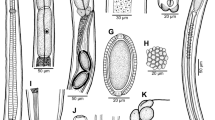Abstract
A new nematode species, Paracapillaria epinepheli, is described from the stomach of the marine fish Epinephelus morio (Valenciennes), the red grouper, (Serranidae, Perciformes) from coastal waters of the Gulf of Mexico in Yucatan, southeastern Mexico. It is characterised mainly by its small body (body length of male and female 2.73–3.22 mm and 5.94–6.35 mm, respectively), number (31–36) and structure of the stichocytes, length of the spicule (0.180–0.195 mm), structure of the male caudal bursa (considerably reduced), structure and size of the eggs (size 0.057–0.063 × 0.027–0.030 mm), and by their site within the host. It is the second Paracapillaria species known to occur in the marine and estuarine fishes of the Gulf of Mexico.
Similar content being viewed by others
References
Aguirre-Macedo, L. & Bray, R.A. (1996) Some trematodes from Epinephelus morio (Pisces: Serranidae) from the coast of the Yucatan Peninsula, Mexico. Studies on the Natural History of the Caribbean Region (in press).
Böhlke, J.E. & Chaplin, C.C.G. (1993) Fishes of the Bahamas and adjacent tropical waters. (Second edition.) Austin: University of Texas Press, 771 pp.
Caballero, G. (1971) Contribución al conomiciento de los nemátodos de peces de los litorales de México. I. Una nueva especie de Capillaria. Revista Iberica de Parasitología, 31, 121–128.
De, N.C. & Maity, R.N. (1994) Paracapillaria xenentodoni n. sp. (Nematoda: Trichuroidea) from the fish Xenentodon cancila (Hamilton) from West Bengal, India. Systematic Parasitology, 27, 71–75.
Deardorff, T.L. & Overstreet, R.M. (1981a) Raphidascaris camura sp. n., Hysterothylacium eurycheilum (Olsen) comb. n., and comments on Heterotyphlum Spaul (Nematoda: Ascaridoidea) in marine fishes. Journal of Parasitology, 67, 426–432.
Deardorff, T.L. & Overstreet, R.M. (1981b) Review of Hysterothylacium and Iheringascaris (both previously Thynnascaris) (Nematoda: Anisakidae) from the northern Gulf of Mexico. Proceedings of the Biological Society of Washington, 93, 1035–1079.
Deardorff, T.L. & Overstreet, R.M. (1981c) Larval Hysterothylacium (= Thynnascaris) (Nematoda: Anisakidae) from fishes and invertebrates in the Gulf of Mexico. Proceedings of the Helminthological Society of Washington, 48, 113–126.
Fajer, E., Valdez, R. & Barrera, M. (1979) Algunos parásitos encontrados en la cherna americana (Epinephelus morio Valenciennes, 1824) en el banco de Campeche. Revista Cubana de Investigaciónes Pesqueras, 4, 43–61.
Layman, E.M. (1930) Parasitic worms from fishes of Peter the Great Bay. Izvesti Tikhookeanskoy Nauchno-promyslovoy Stantsii, 3, 1–120. (In Russian).
Mendonça, J.M. (1963) Sobre dois capillariíneos parasitos de peixes (Nematoda, Trichuroidae). Memórias do Instituto Oswaldo Cruz, 61, 321–327.
Moravec, F. (1987) Revision of capillariid nematodes (subfamily Capillariinae) parasitic in fishes. Studie ČSAV No. 3. Praha: Academia, 141 pp.
Moravec, F., González-Solís, D. & Vargas-Vázquez, J. (1995a) Paracapillaria rhamdiae sp. n. (Nematoda: Capillariidae) from Rhamdia guatemalensis (Pisces) in Yucatan, Mexico. Parasite, 2, 235–238.
Moravec, F., Kohn, A. & Fernandes, B.M.M. (1992) Nematode parasites of fishes of the Paraná River, Brazil. Part 1. Trichuroidea, Oxyuroidea and Cosmocercoidea. Folia Parasitologica, 39, 327–353.
Moravec, F., Vidal-Martínez, V.M. & Aguirre-Macedo, M.L. (1995b) Some helminth parasites of Epinephelus morio (Pisces: Serranidae) from the Peninsula of Yucatan, Mexico. Studies on the Natural History of the Caribbean Region, 72, 55–68.
Moravec, F., Vidal-Martínez, V.M. & Aguirre-Macedo, M.L. (1995c) Philometra margolisi n. sp. (Nematoda: Philometridae) from the gonads of the red grouper, Epinephelus morio (Pisces: Serranidae), in Mexico. Canadian Journal of Fisheries and Aquatic Sciences, 52(Suppl. 1), 161–165.
Moravec, F., Vivas-Rodríguez, C., Scholz, T., Vargas-Vázquez, J., Mendoza-Franco, E. & Gonzáles-Solis, D. (1995d) Nematodes parasitic in fishes of cenotes (= sinkholes) of the Peninsula of Yucatan, Mexico. Part 1. Adults. Folia Parasitologica, 42, 115–129.
Solana-Sansores, R. & Arreguin-Sanchez, F. (1991) Probability sampling design for the artisanal fishery of the red grouper (Epinephelus morio) of Yucatan, Mexico. Ciencias Marinas, 17, 51–72.
Sun, S. & Wu, H. (1993) Fish parasitic nematodes of genus Capillaria in Wuhan and Honghu. Transactions of Researches on Fish Diseases, 10, 129–134. (In Chinese, Engl. summary).
Vidal-Martínez, V.M., Aguirre-Macedo, L. & Moravec, F. (1995) Philometra (Ranjhinema) salgadoi sp. n. (Nematoda: Philometridae) from the ocular cavity of the red grouper, Epinephelus morio (Pisces: Serranidae), from the Peninsula of Yucatan, Mexico. Journal of Parasitology, 81, 763–766.
Author information
Authors and Affiliations
Rights and permissions
About this article
Cite this article
Moravec, F., Mendoza-Franco, E. & Vargas-Vázquez, J. Paracapillaria epinepheli n. sp. (Nematoda: Capillariidae) from the red grouper Epinephelus morio (Pisces) from Mexico. Syst Parasitol 33, 149–153 (1996). https://doi.org/10.1007/BF00009432
Accepted:
Issue Date:
DOI: https://doi.org/10.1007/BF00009432




